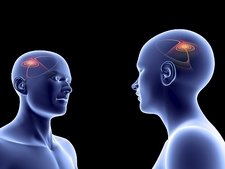Ever wondered why we feel several emotions while watching a movie? Or feel the excitement and tension when watching a football match? The answer lies in an extraordinary set of cells called mirror neurons found in the brain. They were discovered in the mid-1990s in Italy and since then it has revolutionised our understanding of learning, empathy, and social interaction.
What are Mirror Neurons?
Generally, our nervous system has two types of neurons called the motor neurons and the sensory neurons. Motor neurons send signals from the brain to an acting organ, like a muscle, while sensory neurons send signals to the brain from receptors in the skin incase of pain. Their activity is limited to one action: it is either feeling something on the skin or acting to avoid the feeling; they are not active during both times and differ in their functionality. Mirror neurons, on the other hand, are special types of neuron cells that multitask. They are active when the person performs an activity or observes the same activity being performed, combining both motor and sensory aspects of the neurons. These neurons enable us to observe an action, understand the intent behind it, and then perform it to achieve the same results.
The Science of Imitation
Mirror neurons play a huge part in the development of a human persona. After being born, we learn how to walk, talk, behave and be a part of the society in which we live. It is only possible to pull off such feats by watching, learning and imitating the actions of adults around us. It is a long journey to adulthood from childhood, filled with a plethora of experiences that teaches people one thing or the other to be a part of this world. The fact that we can keep up with this ever-changing world is all thanks to these small mirror neurons.
Mirror neurons are found in premotor cortex, supplementary motor area, primary somatosensory cortex, amygdala, thalamus and inferior parietal cortex. These are areas in the brain that specialise in coordinating movements, deciphering sensory information, spatial awareness, decoding emotions, and modulating emotional responses. These qualities make us humans. We smile when someone smiles at us, we wave back when someone does it, the contagious laughs and yawning makes us feel happy and sleepy, understanding feelings when observed on others’ faces, for instance, surprise, admiration, and sadness, the immense surge of emotions felt when listening to music or watching a painting, are all related to the activity of mirror neurons. These brain cells are a part of our evolutionary inheritance and have indeed made us more sophisticated, civilised, and modern in all regards.
What Do They Mean for Us?
Mirror neurons empower us to navigate through different phases of life with human-specific characteristics. However, some individuals have deactivated mirror neuron-enriched regions in the brain. Autistic individuals have impaired imitation systems that hamper their connection with other human beings. Disorders such as Moebius syndrome in children, Parkinson’s disease in adults, schizophrenia and autism spectrum disorder showcase alterations in the abilities to recognise, imitate and regulate facial and bodily expressions. Research on mirror neurons to understand their mechanisms and role in depth is speculated to pave the way for repairing them to a certain extent in people with such disorders. The advent of artificial intelligence is another domain where mirror neurons can be useful. Introduction of the mirror neuron mechanism into robots can result in empathetic and emotional AI. AI systems can further adapt themselves to learn new skills through observation and learning by harnessing the functional features of mirror neurons instead of being pre-programmed. These AI systems can be a boon to elderly people and people with disabilities, facilitating them to lead normal lives, and can increase workforce in the countries lacking it.
To put it simply, the discovery of mirror neurons has opened up a new world to our basis of developing personality and having a standing in the social world. They have influenced our learning, appreciation and empathy. Unravelling these mimic systems continues to provide answers to our developmental questions and possibilities to utilise them for the advancement of humanity. As mirror neurons continue to teach us something new everyday, the next time we find ourselves reverting someone’s actions, let us be thankful and appreciate these little cells that work hard to help us connect with the world around us.

Deeksha, is a Biochemist and an aspiring neuroscientist. Her research interest lies at the intersection of molecular neuroscience and drug discovery.


